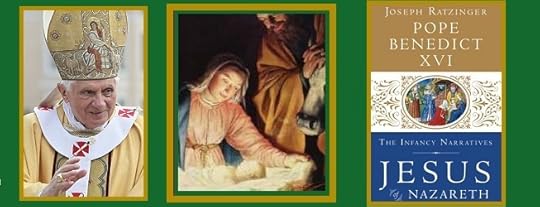Carl E. Olson's Blog, page 116
December 24, 2013
Frank Capra's Forgotten Christmas Classic
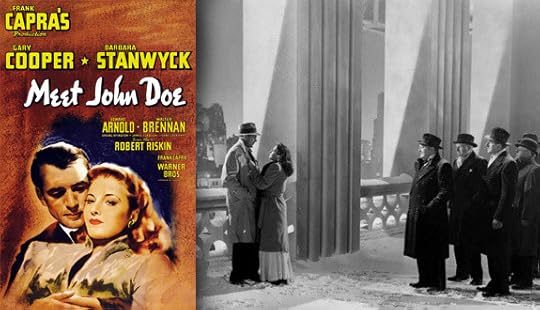
Frank Capra's Forgotten Christmas Classic | Patrick Coffin | CWR
"Meet John Doe" is surprisingly current, even timeless, in its examination of ambition, identity, and repentance
Bring to your mind a scene from a Frank Capra movie: a good man stricken with despair stands at a great height pondering suicide; the snow falls softly all around; it’s Christmas Eve.http://www.typepad.com/site/blogs/6a0...
No, not It’s a Wonderful Life.
I mean the other Capra movie involving the contemplation of suicide on Christmas Eve: the unsung 1941 classic Meet John Doe, that lesser-known of Capra’s odes to Everyman.
Meet John Doe is a story of careers lost, ambitions thwarted, and love unrequited. Well, not quite. In today’s parlance, it’s complicated. Feisty reporter Ann Mitchell (Barbara Stanwyck) has been fired from her gig at the newspaper. When told she owes her boss one last column, she bangs off an angry letter to the editor, “a protest against man’s inhumanity to man and the state of the world.” The last line is a threat to jump off City Hall at midnight on Christmas Eve. And she signs it “John Doe,” an imaginary character who channels her resentment at being let go by her new boss, Mr. Cannell (James Gleason).
That last column generates so much interest in the readers that Cannell decides to put an ad out for ne’re-do-wells who’d like to make some money posing for photos as an angry John Doe. They want a human tabula rasa, a willing candidate for an extreme media makeover.
After an amusing audition montage, who ambles in but a rugged, half-starved bush league pitcher named Long John Willoughby (Gary Cooper at his understated best). Lanky Long John has fallen on hard times and is now accompanied by his rail-riding pal, the Colonel (Walter Brennan), a confirmed hobo and anti-establishment sage. The Colonel smells corruption everywhere and he spends the rest of the movie trying to pull his boxcar buddy away from the “heelots.” Screenwriter Robert Riskin put together one of filmdom’s great comedy speeches, which is worth quoting at some length:
December 23, 2013
An interview with novelist Fiorella De Maria
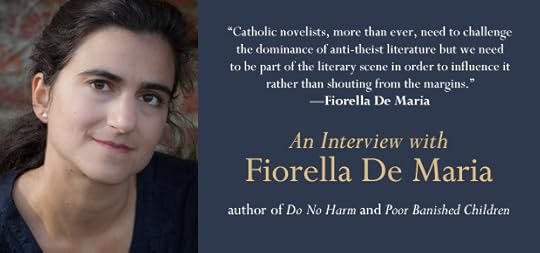
Fiorella De Maria is the author of four novels, including two published by Ignatius Press: Do No Harm and Poor Banished Children. Her other novels are The Cassandra Curse and Father William’s Daughter. Her poetry and short stories have appeared in such publications as Dappled Things. She and her family live in England. Ignatius Press Novels interviewed her via e-mail.
In a previous interview with Ignatius Insight, you described wanting to be a writer from a young age. Do you think being exposed to good art as a child played a role in that?
De Maria: Definitely, perhaps more than anything else. I learnt how to write through reading incessantly. I worked my way through all the classics—the Narnia stories, Alice in Wonderland, then later on Dickens, Austen, Eliot— but I also read a lot of modern, good quality fiction. When you read books as a child, it stretches you in all kinds of ways without you even realising it; your vocabulary improves, you learn the way adult authors articulate ideas, your imagination blossoms. I was also fortunate enough to live near a theatre and was taken to see plays from an early age where I could experience a very different, very immediate form of creativity. I remember being taken to see the original play version of Peter Pan and trembling with fear at the sight of Peter and Wendy stranded on a rock in the middle of a darkening stage, with Peter saying, ‘to die would be an awfully big adventure!’ It amazed me how real it all felt.
Now that you have children of your own, how do you go about introducing literature to them?
De Maria: My children are still very young (the youngest is only one and the eldest seven) but I encourage the older ones to read for pleasure and tell them some of my favourite stories on car journeys. I also try to read to them at mealtimes if there is time, though I have found it can be quite challenging. I was reading through a childhood favourite, Annabel’s Raven, recently and I was laughing so much I had to hand over the book to my husband. I think my children thought I was crazy!
What is your creative process like? Do you have a favorite bit of writing advice?
De Maria: I usually start with a single idea and the characters and plot develop around it. For example, with Do No Harm, it started years ago when I was speaking at a conference and a doctor asked me what doctors in Britain were to do if they were presented with a living will instructing them to remove a patient’s food and fluids (so that the patient would dehydrate to death). As I answered, I think I used the words ‘under pain of an assault charge’ and I just thought, ‘But what if a doctor was charged? What would happen to him?’ The whole novel sprang from that ‘what if?’ moment.
I usually write the opening chapter and the climactic chapter of a novel first, but avoid detailed plans as I prefer the adventure of seeing where the narrative takes me and it ALWAYS goes in a direction I did not initially intend. The characters will develop in a way I did not expect or some small plot detail added at the last minute will change the momentum of the story. I would like to pretend I sit in a book-lined study, writing in a state of reverie for hours with Gregorian chant playing softly in the background, but with four young children I tend to write in snatches and have trained myself to focus very quickly.
The best bit of writing advice I have ever been given is a variant on some words of wisdom given to my sister-in-law when she started at drama school. She was told: “If you can think of anything else you might rather do than be an actor, go and do it. You don’t train as an actor if there is ANYTHING else you would consider doing with your life.’ I think the same is true of writing. I get teenagers coming to me with their work, convinced that they are one step away from stardom and a multi-million pound royalties’ cheque, but the overwhelming majority of authors are not wealthy, the majority are not celebrities, but all of them write because they love to write and can’t imagine doing anything else.
Ignatius Press has published two of your novels, and they are very different: Poor Banished Children is a historical novel, and Do No Harm is a modern legal thriller. Are you more comfortable writing fiction set in modern times, or do you prefer the historical?
Propaganda is Someone Else’s Job
by Dorothy Cummings McLean | IPNovels.com
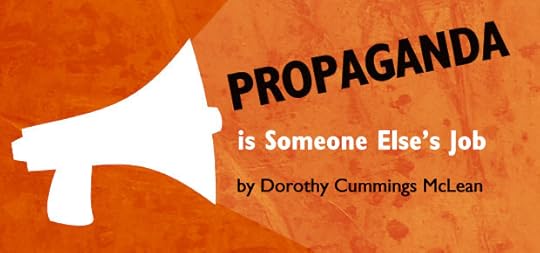
The word “propaganda” now has a pejorative connotation, but once upon a time the Congregation for the Evangelization of Peoples was known as the Sacred Congregation for the Propagation of the Faith, or Sacro Congregatio de Propaganda Fide. I have seen its beautiful headquarters in Rome–designed by Bernini–and been shooed out by a stern security guard. In the context of Christian missionary activity, propaganda-meaning-propagation is a good thing.
Faithful Catholics know that we are supposed always to preach the Gospel, and if necessary, use words, as Saint Francis is reputed to have said. The implication of this quote is that it is better to live the Gospel than to chat about Our Lord with our colleagues at work. I must say that the former sounds more comfortable than the latter. And being Canadian, of mixed Scottish, Irish and German descent, with a dollop of English blood, the idea of standing on a tub at a city corner reading the Gospel through a megaphone does not appeal to me. Perhaps it should, though. And it would be better to shout the Gospel from the tub than in my fiction.
I heard once that Saint Augustine’s works were permeated through and through with the Latin of the Scriptures. I am not sure if this is true, for Saint Augustine and the Vulgate are roughly contemporary. Still, I believe Saint Augustine’s works, like the works of Saint Thomas Aquinas, do ring with echoes of the Scriptures he must have read again and again until they were inextricable from his thoughts. My husband was once a Scottish Episcopalian choir boy, and he will sing or quote from Coverdale’s Psalms in the Book of Common Prayer at the drop of a hat. They are a natural part of his day-to-day noise.
This reminds me that some of the most famous convert novelists–Graham Greene, Evelyn Waugh, Gilbert Keith Chesterton–all had Anglican public [i.e. private] school boyhoods and were therefore steeped in the language and theology of the King James Bible and the Book of Common Prayer. Fellow convert Muriel Spark used the BCP to great effect in her brilliant The Girls of Slender Means. These devotional and liturgical works not only taught these authors Anglican Christianity, they taught them the magnificence of the English language. They didn’t need to shout the Gospel in their work; its echoes were simply there, in their wonderful stories.
It is a terrible pity that there are so few English-language liturgical works of which English-speaking Roman Catholics are uniformly fond, although I imagine we have some favourite hymns, to say nothing of our wonderful Christmas carols.
Christmas, Suffering, and the Cross
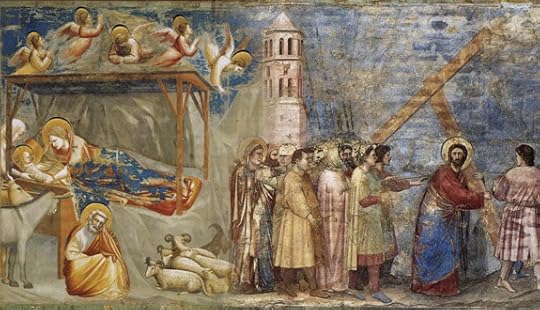
Left: “Nativity: Birth of Jesus” (1306); right: “The Road to Calvary” (1305), both by Giotto.
Christmas, Suffering, and the Cross | Michael Coren | CWR
The witness of those who have sacrificed for others gives us a glimpse into the mystery of the birth of Jesus Christ
I graduated from high school in England back in 1977, and it’s grimly sobering that some of the people reading this column weren’t even born then! Be warned younger people—middle age creeps up on as surreptitiously as the most careful and crafty beasts of prey. There was a somewhat perfunctory party where students and teachers said goodbye to one another, but most of us were only too eager to see the back of school and go on to university, work, fun, whatever. I remained close to my oldest friend, who later was the best man at my wedding, but otherwise I have not maintained contact with most of my contemporaries. Frankly, I can’t even remember their names.
There was one couple, however, who I do remember: Jonathan and Angela. I say “couple” because while only 17-years-old back then, they always seemed to have been together. Not in some prurient way but as surprisingly mature, committed young people. They were also both extremely good-looking, athletic, and intelligent. With so many gifts they could at least have been unpleasant and rude just to balance things out, but they were also kind and generous—the model couple.
I recall Angela speaking to me at the party about her plans but I think I was too busy trying to look at her legs to listen to what she was saying (I wasn’t a Catholic at the time, so it was okay!). After that I pretty much forgot about Angela and Jonathan. I married, came to Canada, started a family, and moved on.
Fast-forward twenty years to a phone-call from that oldest friend. “Are you still visiting London at Christmas,” he asked, “and do you remember Jonathan and Angela?”
December 22, 2013
St. Joseph's doubt and the angel's gift
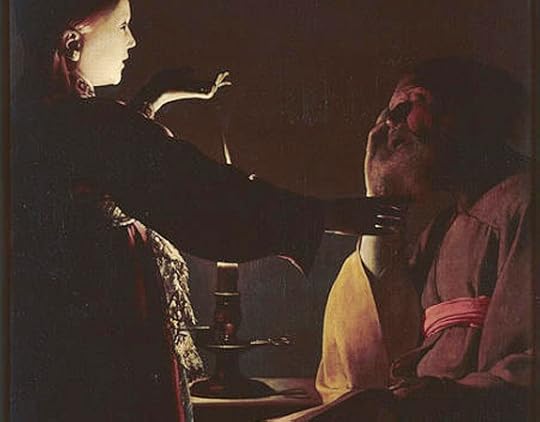
Detail from "The Dream of Saint Joseph" by Francisco de Zurbaran (1635)
A Scriptural Reflection on the Readings for Sunday, December 22nd, Fourth Sunday of Advent | Carl E. Olson
Readings:
• Isa 7:10-14
• Ps 24:1-2, 3-4, 5-6
• Rom 1:1-7
• Mt 1:18-24
“Looking on thee, O Unwedded One,
and dreading a hidden wedlock, O Sinless One,
the chaste Joseph was riven in mind with a storm of doubts…”
That is how the anxious state of Joseph was poetically described by the unknown author of the great Akathist hymn (c. 6th century) to the blessed Virgin Mary as he considered what to do with his young and pregnant betrothed. Joseph, following the usual Jewish practice, had been covenanted to Mary; their betrothal was, for all intents and purposes, as legally binding as marriage. According to Jewish law, this meant the betrothal could only end in one of two ways: divorce or death (Deut. 24:1-4).
Although devotion to St. Joseph has grown tremendously in recent centuries, it is still easy to overlook both the tremendous decisions he faced and the great character he demonstrated in making those decisions. Today’s reading from the Gospel of Matthew describes Joseph as a “righteous man”. This is not some vague reference to Joseph simply being a nice guy, but is a direct recognition of his whole-hearted commitment to the Law. “And it will be righteousness for us,” said the Hebrews at Mount Sinai, upon being given the Decalogue, or Ten Commandments, “if we are careful to do all this commandment before the Lord our God, as he has commanded us” (Deut. 6:25). Joseph was careful to follow the commandments; he desired to love and serve God completely.
Yet he was faced with a gut-wrenching, scandalous situation: a young bride who was already pregnant. However, Joseph was “unwilling to expose Mary to shame” and had decided to divorce her—or, better translated, “to send her away quietly”. Some of the Church fathers and doctors believed that Joseph had suspected Mary of adultery. Others thought he had withheld moral judgment, being genuinely perplexed by the strange situation. And some, including St. Thomas Aquinas, believed Joseph knew of the miraculous nature of Mary’s pregnancy from the start, and had sought to separate himself from her because of a deep sense of unworthiness.
So we don’t know what Joseph knew prior to the angel of the Lord appearing to him. Rather remarkably, we also don’t know what Joseph may have said, simply because not one word that he uttered is recorded! But we do learn some important things from the words of the angel, as well as from Joseph’s actions.
The angel provided Joseph with three essential gifts and truths. First, the divine messenger granted him the gift of peace: “Do not be afraid to take Mary your wife into your home.” The coming of the Lord is always a gift of peace to those who love and serve him.
Secondly, he told Joseph there was a divine plan in place: Mary will give birth to Jesus—which means “Yahweh saves”—who will save his people from sin. Joseph would surely have recognized this as a description of the long-awaited Messiah.
Finally, the angel provided the prophetic background to this stunning event, the passage from Isaiah 7, today’s reading from the Old Testament. This would have further reinforced the reality of the divine plan.
Joseph, in turn, did three things. He thought, first and foremost, about Mary and her wellbeing. He acted justly, without concern for himself, even though he had every legal right to be upset. A good husband puts the needs and reputation of his wife before his own.
Secondly, he placed his trust and hope in God’s promise. Although we never hear any words from Joseph, we are told of his actions. A godly man walks the talk, but with a minimum of talk!
Third, Joseph embraced the daunting task of being the foster father of the Son of God. Why? Because he trusted in God despite the strangeness of the situation.
And what is the conclusion of the verse of the Akathist hymn quoted above? “…but learning that your conception was of the Holy Spirit, he cried out: ‘Alleluia!’” Alleluia, indeed!
(This "Opening the Word" column originally appeared in the December 19, 2010, issue of Our Sunday Visitor newspaper.)
December 21, 2013
Francis' Christmas greetings to Curia emphasizes professionalism, service, holiness
Today, the Holy Father delivered his first Christmas address to the Roman Curia. Rocco Palmo observes at Whispers in the Loggia, during Benedict XVI's pontificate, the annual reflection became one of the more anticipated papal addresses of the year. What would be the approach taken by Francis?
Like so much else this time around, it was unclear what Pope Francis would do with his first turn at the speech today... but given the Argentine pontiff's habit for dropping rhetorical bombs at any time – especially when top officials are present – most observers went into this morning's appointment expecting more, not less. While the result was much briefer than Benedict's elegant, detail-rich meditations in years past, the new Pope's usual "three words" on this occasion still packed a considerable punch.
Here is the full text of the address, as translated by Vatican Radio:
Your Eminences,
Dear Brother Bishops and Priests,
Dear Brothers and Sisters,
Once again the Lord has enabled us to journey through Advent, and all too quickly we have come to these final days before Christmas. They are days marked by a unique spiritual climate made up of emotions, memories and signs, both liturgical and otherwise, such as the crèche. It is in this climate that this traditional meeting takes place with you, the superiors and officials of the Roman Curia, who cooperate daily in the service of the Church. I greet all of you with affection. Allow me to extend a special greeting to Archbishop Pietro Parolin, who recently began his service as Secretary of State, and who needs our prayers!
While our hearts are full of gratitude to God, who so loved us that he gave us his only-begotten Son, it is also good to make room for gratitude to one another. In this, my first Christmas as the Bishop of Rome, I also feel the need to offer sincere thanks to all of you as a community of service, and to each of you individually. I thank you for the work which you do each day: for the care, diligence and creativity which you display; and for your effort – I know it is not always easy – to work together in the office, both to listen to and to challenge one another, and to bring out the best in all your different personalities and gifts, in a spirit of mutual respect.
In a particular way, I want to express my gratitude to those now concluding their service and approaching retirement. As priests and bishops, we know full well that we never really retire, but we do leave the office, and rightly so, not least to devote ourselves more fully to prayer and the care of souls, starting with our own! So a very special and heartfelt “thank you” goes to those of you who have worked here for so many years with immense dedication, hidden from the eyes of the world. This is something truly admirable. I have such high regard for these “Monsignori” who are cut from the same mould as the curiales of olden times, exemplary persons. We need them today, too! People who work with competence, precision and self-sacrifice in the fulfilment of their daily duties. Here I would like to mention some of them by name, as a way of expressing my esteem and my gratitude, but we know that, in any list, the first names people notice are the ones that are missing! Besides, I would also risk overlooking someone and thus committing an injustice and a lack of charity. But I want to say to these brothers of ours that they offer a very important witness in the Church’s journey through history.
This mould and this witness make me think of two hallmarks of the curial official, and even more of curial superiors, which I would like to emphasize: professionalism and service.
Professionalism, by which I mean competence, study, keeping abreast of things. This is a basic requisite for working in the Curia. Naturally, professionalism is something which develops and is in part acquired; but I think that, precisely for it to develop and to be acquired, there has to be a good foundation from the outset.
The second hallmark is service: service to the Pope and to the bishops, to the universal Church and to the particular Churches. In the Roman Curia, one learns – in a real way, “one breathes in” – this twofold aspect of the Church, this interplay of the universal and the particular. I think that this is one of the finest experiences of those who live and work in Rome: “to sense” the Church in this way. When professionalism is lacking, there is a slow drift downwards towards mediocrity.
Dossiers become full of trite and lifeless information and incapable of opening up lofty perspectives. Then, too, when the attitude is no longer one of service to the particular Churches and their bishops, the structure of the Curia turns into a ponderous, bureaucratic customs house, constantly inspecting and questioning, hindering the working of the Holy Spirit and the growth of God’s people.
To these two qualities of professionalism and service, I would also like to add a third, which is holiness of life. We know very well that, in the hierarchy of values, this is the most important.
Indeed, it is basic for the quality of our work, our service. And I want to say here that in the Roman Curia, there have been and there are saints; I have said this in public more than once, to thank the Lord. Holiness means a life immersed in the Spirit, a heart open to God, constant prayer, deep humility and fraternal charity in our relationships with our fellow workers. It also means apostleship, discreet and faithful pastoral service, zealously carried out in direct contact with God’s people. For priests, this is indispensable.
Holiness in the Curia also means conscientious objection to gossip! We rightfully insist on the importance of conscientious objection but perhaps we, too, need to exercise it as a means of defending ourselves from an unwritten law of our surroundings, which unfortunately is that of gossip. So let us all be conscientious objectors; and mind you, I am not simply preaching! Gossip is harmful to people, our work and our surroundings.
Dear brothers and sisters, let us feel close to one another on this final stretch of the road to Bethlehem. We would do well to meditate on Saint Joseph, who was so silent yet so necessary at the side of Our Lady. Let us think about him and his loving concern for his Spouse and for the Baby Jesus. This can tell us a lot about our own service to the Church! So let us experience this Christmas in spiritual closeness to Saint Joseph.
I thank you most heartily for your work and especially for your prayers. Truly I feel “borne aloft” by your prayers and I ask you to continue to support me in this way. I, too, remember you before the Lord, and I impart my blessing as I offer my best wishes for a Christmas filled with light and peace for each of you and for all your dear ones. Happy Christmas!
December 20, 2013
20% off great titles from Ignatius Press (now through Dec. 24th)

Offer ends Tuesday, December 24th, 2013 at 12:00 midnight EST.
These prices are available online only through Ignatius.com
20% Off Great Titles from Ignatius Press!
New Novel
"What happens when your quiet life is disrupted by tragedy? What happens when your day-to-day busy-ness is disrupted by eternity? As one of the characters in this tale says, "The unforeseen has a way of happening." But what then? What happens when your faith really has to matter? This lovely story will pull you in and will not let you go. But it will surprise you. So will life."
- Dale Ahlquist, President, American G. K. Chesterton Society
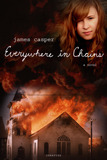 Everywhere in Chains: A Novel
Everywhere in Chains: A Novel
James Casper
This highly thought-provoking, sometimes amusing and always life-affirming novel illustrates one family's experiences with America's criminal justice system. As Penelope searches for the truth about her father, she rattles the skeletons in her family's closet and shakes up the complacency of her community, which has tried to sweep the past under the rug. With both perception and compassion, the author creates a colorful cast of characters while challenging the wisdom of imprisoning the mentally ill.
On the cusp of adulthood, Penelope begins to understand that she has grown-up in a web of silence. The denial in her family and small Minnesota hometown is so thick that she does not know how to cut through it, that is, until she begins a seemingly innocuous pen-pal correspondence with someone in another town. Little by little, Penelope unravels the secrets meant to protect her from the truth. She proves herself to be stronger and wiser than anyone could have predicted and leads the way to healing. Also available as an e-book.
Regular price: $22.95, sale price: $18.36
Pope declares Jesuit Pierre Favre a saint
By Associated Press, Updated: Tuesday, December 17, 10:23 AM
VATICAN CITY — Pope Francis has declared the 16th-century Jesuit Pierre Favre a saint, bypassing the Vatican’s typical saint-making procedures to honor the first recruit of Jesuit founder St. Ignatius Loyola.
The announcement was made Tuesday on Francis’ 77th birthday, something of a gift to his Jesuit family for whom Favre is a beloved role model. Keep reading here.
Learn more about the life of the now Saint Peter Favre in the Ignatius Press title To the Other Towns. See details below.
 To the Other Towns: The Life of Blessed Peter Favre, First Companion of St. Ignatius
To the Other Towns: The Life of Blessed Peter Favre, First Companion of St. Ignatius
William Bangert
While it is well remembered that St. Francis Xavier was an original companion of St. Ignatius at the beginning of Jesuit Order, it has too often been forgotten that there was a very important third person who made up the original trio that were the foundation stones upon which Ignatius built the Society of Jesus. That third person was Blessed Peter Favre, the quiet, gentle and congenial companion of Francis Xavier and Ignatius who labored tirelessly to preach the Gospel with ceaseless travel through Italy, Portugal, Germany and the Netherlands, going wherever he was ordered by Ignatius to lay Jesuit foundations and win souls for Christ.
This is the life of Peter Favre, first companion of St. Ignatius, a holy and energetic missionary who, as a young college student had met Ignatius and Francis Xavier at the University of Paris in 1525, and there began the origins of the great Society of Jesus. In this inspiring biography, Fr. William Bangert, S.J., has drawn on many essential historical sources and consulted various experts and documents to present a detailed, moving portrait of this prayerful, humble and zealous Jesuit who spent himself for the cause of Christ, packing into the last seven years of his forty years on earth an incredible program of travel and work that kept him always on the move "to the other towns" to proclaim the Kingdom of God. Also available as an e-book.
Regular price: $14.95, sale price: $11.96
New Spanish Titles
 Aprender a amar: 30 preguntas para no equivocarse en la aventura más importante de la vida
Aprender a amar: 30 preguntas para no equivocarse en la aventura más importante de la vida
Pontificio Instituto Juan Pablo II
Cuando nace una relación, la cuestión surgida por la pregunta «¿me amas?» no se puede contestar en soledad, requiere un acompañamiento. El Instituto Juan Pablo II, creado por el Papa para estudiar el matrimonio y la familia, no podía sino sentirse interpelado por esta pregunta de los jóvenes, y por ello ha preparado este documento: Aprender a amar. 30 preguntas para no equivocarse en la aventura más importante de la vida. En él simplemente se recogen las preguntas que los jóvenes llevan en su corazón. Es lo que hacía el Papa en sus encuentros con la juventud cuando decía: «Lo que yo os voy a decir no es tan importante como lo que vosotros me vais a contar a mí».
Regular price: $5.95, sale price: $4.76
Learning to Love: 30 Questions to Avoid Mistakes on the Most Important Adventure in Life
The John Paul II Institute on marriage and family prepared this document with 30 key questions on the meaning of love.
 San Maximiliano Kolbe: Mártir de la caridad
San Maximiliano Kolbe: Mártir de la caridad
Felix Ochayta
En san Maximiliano M.ª Kolbe, cuya heroica muerte en el campo de concentración de Auschwitz sigue conmoviendo, se hermanan la vocación religiosa y la sacerdotal, el amor a la Inmaculada y el ansia de martirio, la adhesión a la tradición de la Iglesia y la apertura al mundo moderno.
Fue un testigo de la dignidad y el valor de la persona humana en el atormentado siglo XX, un sacerdote moderno, maestro y modelo de sacerdotes, a quien Juan Pablo II declaró «Patrono de nuestro difícil siglo». La lectura de esta obra comprueba la exactitud y justicia de esta declaración. A todos será útil, especialmente a sacerdotes, seminaristas y devotos en general de la Madre Inmaculada.
Regular price: $12.95, sale price: $10.36
Saint Maximillian Kolbe: Martyr of Charity
Maximillian Kolbe was a witness to the value and dignity of the human person in the 20th century, a great teacher and model for priests. This book tells his inspiring story.
 Historia de un alma
Historia de un alma
Therese de Lisieux
Santa Teresa de Lisieux ha sido un huracán de gloria desde su muerte a los veinticuatro años de edad. Teresa fue una joven carmelita que impresionó a toda clase de personas en todo el mundo: intelectuales y analfabetos, activos y contemplativos, cristianos fervorosos y no practicantes, y hasta incluso a no cristianos. Teólogos eminentes como Philipon y H. Urs von Balthasar han puesto de relieve la vida y los escritos de esta mujer oculta en el Carmelo.
Con el título de Historia de un alma, Inés de Jesús, priora del mismo convento y hermana de la santa, publicó, algo retocados, los «Manuscritos autobiográficos» de Teresa un año después de su muerte. Desde el año 1957 se ha logrado la edición auténtica, sin añadiduras ni recortes, de dichos manuscritos.
Regular price: $12.95, sale price: $10.36
Story of a Soul: St. Therese of Lisieux: This is the classic autobiography of the saint.
 Presente y futuro del Concilio Vaticano II
Presente y futuro del Concilio Vaticano II
Marc Cardinal Ouellet
Cincuenta años después de la apertura del Concilio Vaticano II, que ha supuesto un importante cambio en la historia de la Iglesia, el papa Benedicto XVI promulgó el Año de la Fe, a partir de octubre de 2012. Lejos de convocar un nuevo concilio e igualmente opuesto a la idea de arrojar el Vaticano II a las mazmorras de la historia, el cardenal Marc Ouellet nos entrega con confianza la certeza de la fe contenida en las cuatro constituciones conciliares y los decretos consiguientes. «Es necesario volver al Concilio», decía el beato Juan Pablo II en el año 2000. Y esto precisamente es lo que el cardenal Ouellet quiere proponer en esta interesante entrevista que mantuvo con el P. Geoffroy de la Tousche.
Regular price: $12.95, sale price: $10.36
The Relevance and Future of the Second Vatican Council
Fifty years after the opening of the Second Vatican Council, Cardinal Marc Ouellet-considered by many to have been a top candidate to succeed Pope Benedict XVI-gives his thoughts on the Council and what the Vatican II means for us today. In interviews with French priest Fr. Geoffroy de la Tousche, Cardinal Ouellet speaks both personally and professionally about the state of the Church since the Council, explaining what went wrong-and right-in the implementation of the Council's teachings.
Announcing...
Online Great Books major, BA degree from
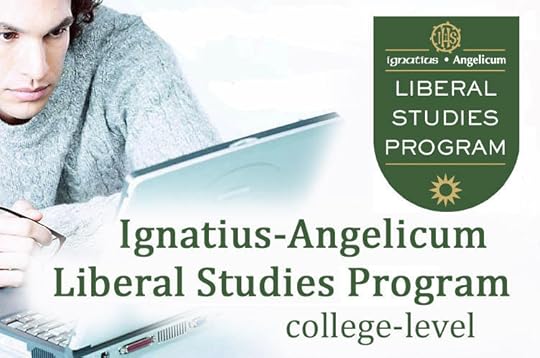
The Ignatius-Angelicum Liberal Studies Program and Holy Apostles College & Seminary are pleased to announce that LSP online students may apply any or all of their American Council on Education (ACE CREDIT) recommended credits (60 total) towards their BA degree at Holy Apostles, including towards the new Holy Apostles Great Books major. The American Council on Education's College Credit Recommendation Service (ACE CREDIT) has recommended the LSP Great Books Program online for 48 college credits (6 per semester/8 semesters) and the LSP Theology Online courses (lectures by Fr. Joseph Fessio for 12 college credits 4 courses - 3 credits each) - that's a total of 60 hours, which is 2 years of college credit (1/2 of a typical BA degree) completed before you enter college.
Holy Apostles College & Seminary campus is located in historic Cromwell, Connecticut, easy driving distance for a day trip to either New York City or Boston and welcomes distance learning students, lay commuter students, as well as seminarians. Besides the on-campus undergraduate, graduate, and seminary degrees in philosophy & theology offered on-campus, 18 courses are scheduled to be offered through the Holy Apostles Distance online Learning program, undergraduate level, for the Spring 2014 semester. Graduate courses may be used for credit toward the M.A., Post Master’s Certificate in Theology, and M.Div. programs, as well as for Certificate programs. Holy Apostles College & Seminary is a regionally accredited, co-educational Catholic college for lay and clerical students.
Contact: 719.930.7549 or info@angelicum.net
Learn more about the Liberal Studies Program at: http://angelicum.net/liberal-studies-program-faq/
Catholic World Report
Evangelii Nuntiandi: “The greatest pastoral document that has ever been written”
By J. J. Ziegler

Pope Francis has been candid about his appreciation for Paul VI’s 1975 apostolic exhortation. Many theologians and evangelization experts agree that the document has remained relevant and challenging to the Church today.
Readers of Blessed John Paul II’s documents have noted his frequent references to a sentence in Gaudium et Spes , the Second Vatican Council’s Pastoral Constitution on the Church in the Modern World: “man, who is the only creature on earth which God willed for itself, cannot fully find himself except through a sincere gift of himself” (no. 24).
Similarly, readers of Pope Francis’ writings have observed his frequent references to Evangelii Nuntiandi , Venerable Paul VI’s 1975 apostolic exhortation on evangelization. Pope Francis has cited it at least 31 times on at least 11 different occasions, including 13 times in his new apostolic exhortation Evangelii Gaudium. Evangelii Nuntiandi is an important part of the soil from which the teaching of Evangelii Gaudium has sprung; to use another image, they are akin to two plates of a diptych ...
Homiletic & Pastoral Review
Jesus’ Infancy through the Eyes of Benedict XVI
By Dr. Matthew J. Ramage, Ph.D.

As Benedict’s entire Jesus of Nazareth trilogy masterfully illustrates, the answer lies in carefully balanced exegesis that takes the historicity of the Gospels seriously, while also attending to the particularities of their unique literary form.
It is time to stop and pay close attention when the theologian you are reading starts talking about his “method.” In the final volume of his Jesus of Nazareth series of books, released a year ago this Advent, Benedict XVI painted a beautiful portrait of Jesus’ early life, but he began it with a discourse concerning method.
As we prepare for the season of Advent, it is worth following Benedict’s advice to step back for a moment before we delve into our meditation upon the events surrounding Jesus’ birth: “Before we consider the content of the texts,” the emeritus pontiff says, “a brief word about their particular literary character is necessary...
Copyright © 2013 Ignatius Press, All rights reserved.
December 19, 2013
New: "Revolution in Rio: The Best of WYD 2013"
Now available from Ignatius Press:
Revolution in Rio: The Best of WYD 2013
• DVD | 55 minutes
This DVD can only be sold in the US and Canada.
Revolution in Rio is a pulsating 55-minute documentary that will help you experience all the highlights of WYD in Rio de Janeiro in August 2013.
More than three million young people around the world responded enthusiastically to the invitation of Pope Francis, and you can experience that incredible enthusiasm of youth for the challenges presented by the charismatic Pope. Six unforgettable days synthesized in 55 intense minutes that mix humor, fervor, cry and love in joyful symphony. With several wonderful bonus extras.
The film includes many "thriller" moments of celebration, art, and drama, with a dynamic soundtrack and interspersed with brief interviews of young people at WYD. It ends with the prophetic witness of Pope: "Christ is preparing a new springtime in the world".
The DVD also contains 50 minutes of Extras, including the top songs of World Youth Day, the Pope's special speech to young Argentines, a photo gallery, and an extract of the biography of Pope Francisco.
Plus, the first 2,000 copies of this DVD will include a free copy of the CTS Booklet, Pope Francis!
This DVD contains the following language options: English or Spanish
Trailer:
A Small Thing, Packaged Big

Martin Freeman stars as Bilbo and John Callen as Oin in a scene from the movie "The Hobbit: The Desolation of Smaug." (CNS/courtesy of Warner Bros. Pictures)
A Small Thing, Packaged Big | Andrew Svenning | CWR
The Hobbit: The Desolation of Smaug suffers from poor pacing, too many special effects, and lack of focus.
When the rumblings began that The Hobbit, J.R.R. Tolkien’s prelude to his larger work, The Lord of The Rings, was coming to the big screen, I had reservations, but wasn’t put off entirely. After all, Peter Jackson was on board and I was generally impressed by his cinematic treatment of the trilogy, so optimism seemed warranted. Further credence seemed to come when it circulated that Guillermo Del Toro, a director with a clear eye for the mythological and fantastic who is noted for his love of practical, rather than computer-generated, effects, would collaborate with Jackson in realizing the more fairy-tale tone of the first foray into Middle Earth. But as MGM’s financial fiasco took its toll and stalled the project and Del Toro’s involvement evaporated—followed by the news that The Hobbit would be not one, but two films—worry crept in.
The Hobbit is, by all accounts, a smaller story than the epic Lord of the Rings. Jackson managed to make his Lord of the Rings a trilogy, with each book as one cinematic installment, at a time when the Weinstein brothers were interested in truncating the series into two movies. How was it, then, that one book of about 300 pages needed two movies, when a trilogy of more than 1,000 pages could manage in three? Then the news came out—not just two movies, but a new trilogy. The Hobbit was now a smaller thing, packaged big. It seemed that Tolkien was being treated to the new Hollywood truism of never telling a good—and financially lucrative—story too quickly.
I am not a purist; I am not opposed in principle to books being changed when adapted to the screen. Books are books and movies are movies. A little added here and a little removed there is going to be part of the polishing process as the story is imported from one medium to the other. But the new Hobbit film, The Desolation of Smaug, continues to demonstrate just how far south too much changing can go. When making any change in adapting a book to film, it should always be asked if the change harms the theme, intention, or characters of the original story. It also should be asked if the change helps the story work better within the limitations of a movie’s runtime.
The main problem with many of the changes and additions in The Desolation of Smaug is that they throw off the rhythm, allowing little or no time to develop either the invented plot elements or the original story. Am I opposed, in principle, to the addition of a burgeoning interracial romance between an invented elf warrior (Evangeline Lilly) and Kili the Dwarf? (If you were wondering why there was an oddly, ruggedly handsome man among the dwarves in the first film, this is the reason.) Perhaps not—if it is dramatically plausible and doesn’t stick out as contrived.
One of the big problems with the changes—some included to better connect with the LOTR films and some to stretch the Hobbit’s story to fill three films—is that they are creating waves of distortions in the overall storyline.
December 17, 2013
Jesus’ Infancy through the Eyes of Benedict XVI
Jesus’ Infancy through the Eyes of Benedict XVI | Dr. Matthew J. Ramage, Ph.D. | HPR
As Benedict’s entire Jesus of Nazareth trilogy masterfully illustrates, the answer lies in carefully balanced exegesis that takes the historicity of the Gospels seriously, while also attending to the particularities of their unique literary form.
It is time to stop and pay close attention when the theologian you are reading starts talking about his “method.” In the final volume of his Jesus of Nazareth series of books, released a year ago this Advent, Benedict XVI painted a beautiful portrait of Jesus’ early life, but he began it with a discourse concerning method.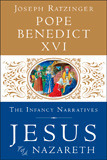 As we prepare for the season of Advent, it is worth following Benedict’s advice to step back for a moment before we delve into our meditation upon the events surrounding Jesus’ birth: “Before we consider the content of the texts,” the emeritus pontiff says, “a brief word about their particular literary character is necessary.”
As we prepare for the season of Advent, it is worth following Benedict’s advice to step back for a moment before we delve into our meditation upon the events surrounding Jesus’ birth: “Before we consider the content of the texts,” the emeritus pontiff says, “a brief word about their particular literary character is necessary.”
That the Gospels have a “particular literary character” is something that many Catholics find hard to appreciate. People in the pews are generally aware that the Gospels are not transcripts of Christ’s life such as we would possess if video cameras had existed 2000 years ago. The faithful also have the sense that the Gospels are more than mere legends or myths. But how is the average person supposed to determine what historical claims are actually being made in the Gospels? And on what grounds are they to base their trust in the Gospels as histories of Jesus’ life?
In his characteristically sober, forthright manner, Benedict ties these questions together: “Finally, we must ask in all seriousness: when the evangelists Matthew and Luke tell us, in their different ways, and following different traditions, about Jesus’ conception from the Virgin Mary by the power of the Holy Spirit, is this a historical reality, a real historical event, or is it a pious legend?” We discover a clue to answering this challenge right at the outset of Benedict’s reflection on the Annunciation. He tells us that attempts have been made to see in the Gospel a sort of haggadic midrash. With this interpretative method, the ancient rabbis had sought to explain difficult portions of pre-existing biblical stories by crafting new narratives based on them. In doing so, a rabbi might condense a biblical text, expand it, fill in gaps, or clarify potentially misleading verses.
One of my favorite examples of this, outside the Bible itself, is found in the Book of Jubilees.
Carl E. Olson's Blog
- Carl E. Olson's profile
- 20 followers


